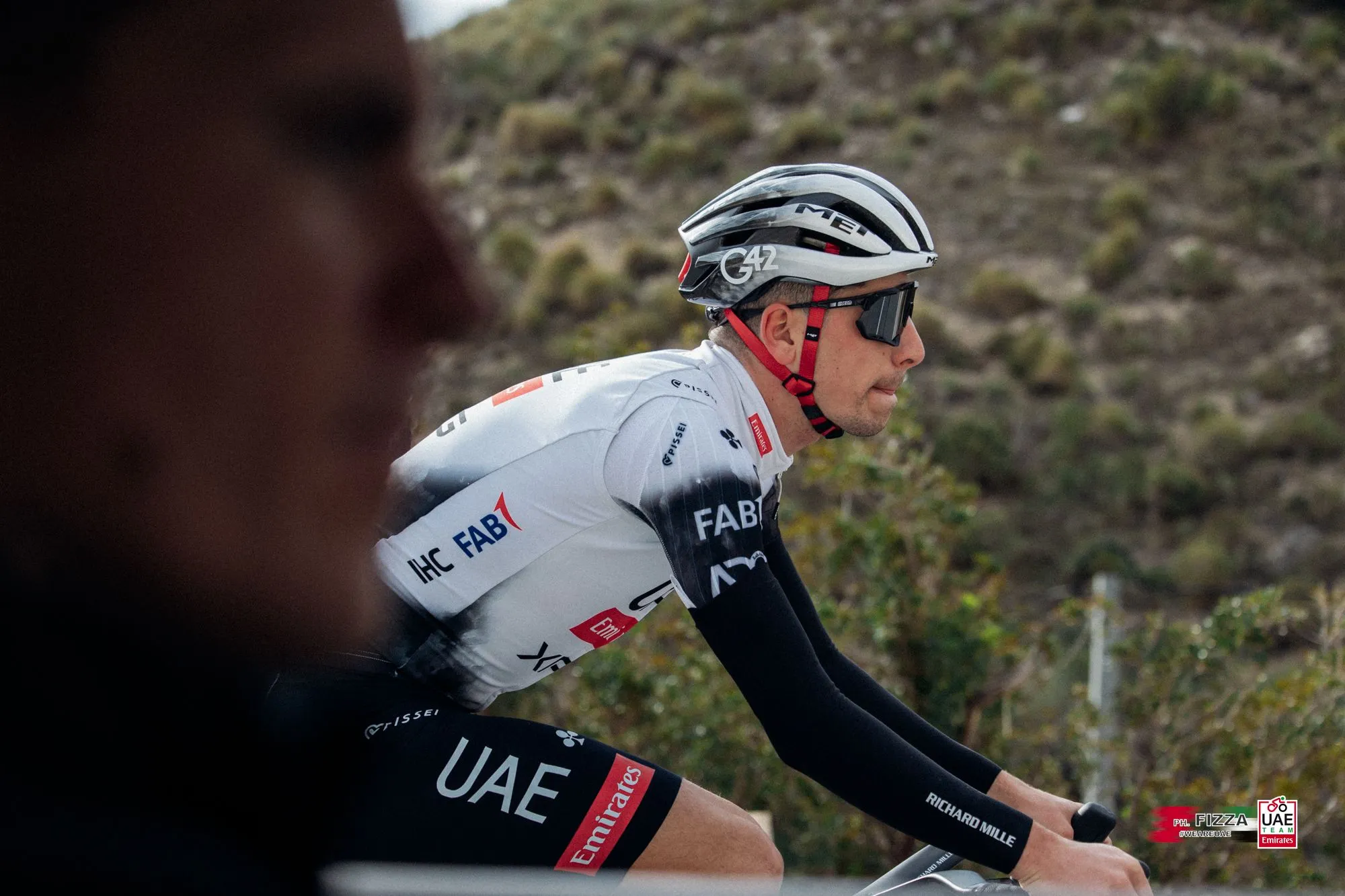UCI shakes things up with gear restrictions, wildcard updates, and overhaul of points system
CyclingThursday, 19 June 2025 at 14:14

The UCI is busy reforming several aspects of cycling. Next year, and in some cases this year, the International Cycling Union will implement several changes in areas such as safety. The points system will also be overhauled and clarified rules will be introduced for bunch sprints, points classifications, and bad weather.
For example, the five-kilometer rule will be clarified. It replaces the three-kilometer rule, but the UCI clarifies that this only applies to specific circumstances: the rule may only be observed where a mass sprint is expected. There was some confusion about this; some races applied the rules in the middle mountains. That is not the intention.
Then, the big one: the points system. In WorldTour races, the winner could previously earn 300 points for races such as the Renewi Tour or the Classic Brugge-De Panne. For races such as the E3 Saxo Classic and the Flèche Wallonne, 400 points could be earned, and for winning the Critérium du Dauphiné or the Amstel Gold Race, 500 points were awarded. The higher categories could earn even more points (Monuments, Grand Tours). But from 2026, there will be fewer categories in WorldTour races.
From next year, the winner of a WorldTour race will earn at least 400 points. This puts the Renewi Tour on par with the Tour of Catalonia. The Strade Bianche, UAE Tour, and Flèche Wallonne will, in turn, be upgraded to races worth 500 points. The same new points system will also apply to WorldTour races for women. The UCI ProSeries (e.g., the Baloise Belgium Tour) will also be upgraded: the winner will now earn 250 points instead of 200.
Read more below the photo!
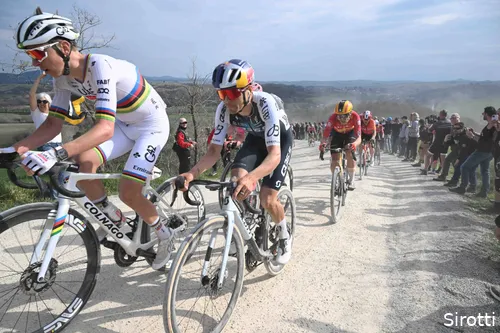
The Strade Bianche is now in the UCI points count only under Monuments and Grand Tours.
New safety measures: extreme weather, regulators and more
A separate change can be seen regarding the Extreme Weather Protocol. This was brought into being to ensure the safety of riders in bad weather. A meeting before the start is mandatory, where the UCI commissaries talk to the organization, while the CPA (riders' union) is also present. This protocol now applies to WorldTour races, ProSeries, and class 1 races (e.g., Volta NXT Classic), but only if at least eight teams at the WorldTour or Pro-continental level are starting. For women, that number is reduced to six teams.
However, the UCI has decided to tighten the safety protocols with the help of regulators. A regulator is someone from the organization responsible for the riders' safety during the race. They will oversee the race on a motorcycle. Now, two regulators must be present in WorldTour races and one in ProSeries races. For other races, the UCI strongly recommends the presence of such an official.
In addition, the UCI wants to conduct tests by reducing the bikes' gears. As of August 1, some races will have new rules, allowing a maximum gear ratio of 54 teeth in front and 11 in the rear. This measure is intended to reduce speed and thereby increase safety, despite considerable criticism of—but also support for—the ideas of the International Cycling Union.
Read more below the photo!
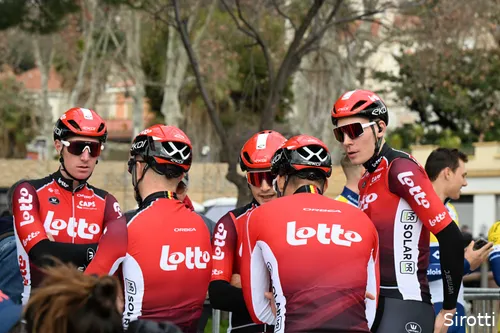
In addition to Lotto and Israel, another ProTeam will get a regular starting spot in the grand tours.
Second in the points classification? You may not be able to wear green
There is also news about the Wildcards, although it is not really new news. From 2026, the major tours will be required to reserve three places for the best UCI ProTeams, i.e., the pro-continental teams. Previously, there were two places: Lotto and Israel - Premier Tech are currently entitled to those places, but a third team will be added. This also means that the organizations will only have two real Wildcards left. This rule also applies to other stage races.
We're not done with the changes yet. A few minor adjustments: from 2026, a maximum of 72% of the teams in a WorldTour-level ProSeries race may be WorldTour teams. That was 70%, a change of nothing, it seems. However, it does mean that if there are 18 teams at the start, 13 WorldTour teams can now start instead of 12.
Finally, a new rule: if a leader in a secondary classification already has another jersey, the number two in that classification will wear that jersey. This is not new, of course, but if the number two is wearing a champion's jersey (national, continental, or world champion), he must wear that jersey. The jersey for the secondary classification then goes to the number three.
Read also
IDL-productions

? - Premier Tech may leave Israel, noisy 2025 ánd era-Froome behind, but also loses heavy weights

A career of staying out of trouble and a lot of wins: with Arnaud Démare, the peloton loses a massive character

Sudden doping case around Lazkano pushes devastating verdict on Movistar into the background

"We already knew Wout from the Tour": how Poels’ transfer to Unibet Tietema Rockets came together

🎥 Anyone who saw Tom Pidcock dominate for Q36.5 on a 22 percent (!) climb should’ve known better back then
Latest Cycling News

Cycling news at your fingertips: Follow IDL Procycling everywhere!

"I’ll take those conversations to my grave", writes NBA legend Reggie Miller, after 'unfiltered conversation' with Van Aert

Sand, Wind and Winners: Van der Heijden leads all-Dutch podium as Agostinacchio, Bukovská take European gold

📸 Quinn Simmons, Gaviria, Hindley and Derek Gee-West seize weeks without a bike to say 'yes'

"Bas Tietema and his Unibet Rockets may be about to reel in a whopper from the WorldTour pond"
Popular Cycling News
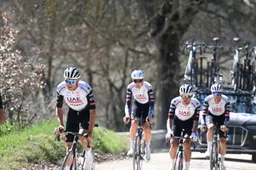
EF Education - EasyPost keeps can't stop signing top talents and snatches a third one - this time a UAE-star
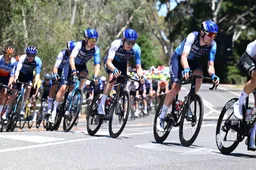
Premier Tech walks away despite name change: co-title sponsor quits cycling team with immediate effect

Armstrong steps in again: Wiggins heads to top US trauma clinic — while his friend pays the full bill

Modern Adventure Pro Cycling is a go: Hincapie at the helm, eye-catching names and a British top talent

After Premier Tech’s exit, team has not yet found a replacement: “Not done in consultation with the team”
Latest Comments
- Now the Palestinian protestors can stop their whining. Trump came to the rescue. So they can now STFU and go back to waving the rainbow flags.raufus15-10-2025
- Cracked the code lol. If it was that easy to 'crack the code' jonny Vegas would be charging up the Kwaremont giving Pog a dose of his medicine. Evenepoel can't match pog on a climb and neither can mvdp. Anything with a half difficult climb and Pog smashes the field. Even on flat(ish)parcours like Roubaix it came down to a mistake and crash by pog to definitively crown mvdp. MSR is the only one that Pog probably won't win.kevpt10-10-2025
- We've seen this movie before. I think Pogacar is doping.DeadBlow10-10-2025
- 👍Bea08-10-2025
- 👌🏻Bea08-10-2025
- What the data doesn't show is how much of an effect drafting had for evenepoel. Pogacar went with del toro at 100km whilst Evenepoel was still in the bunch. Despite the bike changes he still had a lot of assistance getting back to the bunch. Pogacar then rode 60km solo whilst evenepoel rode with Healy/Skjelmose until going solo in thd last 10-15km. Thats ~20% less power / energy requirements for 45-50km. Apples and oranges...kevpt30-09-2025
- 👏👏Bea24-09-2025
- Agreed! As we all know now, Juan Ayuso will be on another team. But it was sweet to see him win the stages at La Vuelta. I do love the drama of cycling admittedly but its clear to see the talent of winners of stages in a Grand Tourryhw2814fq921-09-2025
- Pogacar has no competition he has won everything, I cant imagine even being him in that position!! Crazy. I am sure he has some back up plan for how he wants to spend his retirement years at age 30 onward. Does he like beer? Plenty of innovation in brewing. And you don't have to be super social. Chapeau/Cheers whatever you like Tadej you will do.ryhw2814fq921-09-2025
- Plus its confirmed that the Philadelphia Cycling Classic up the Manayunk Wall is back for 2026! hooray for thatryhw2814fq918-09-2025
Loading
